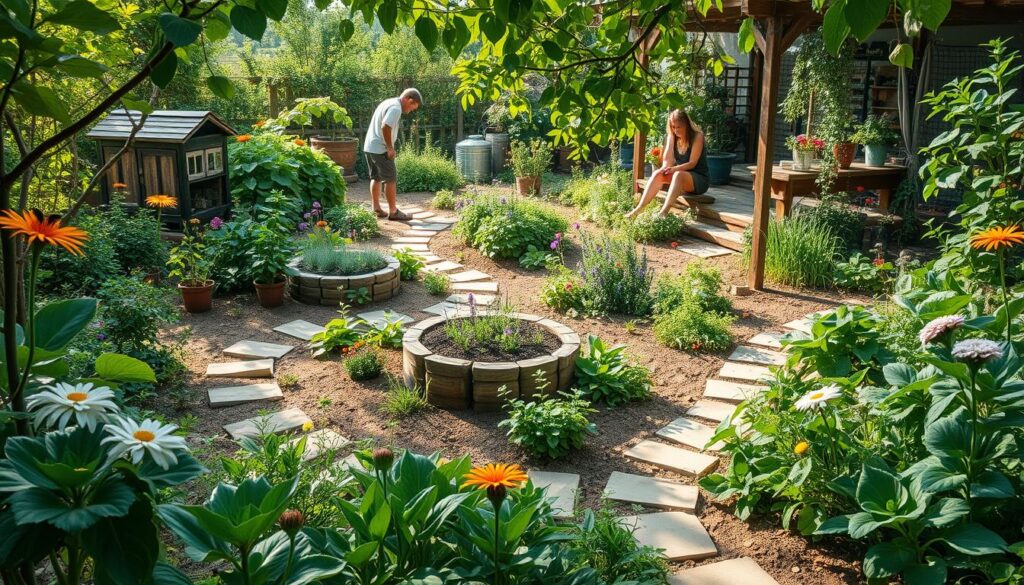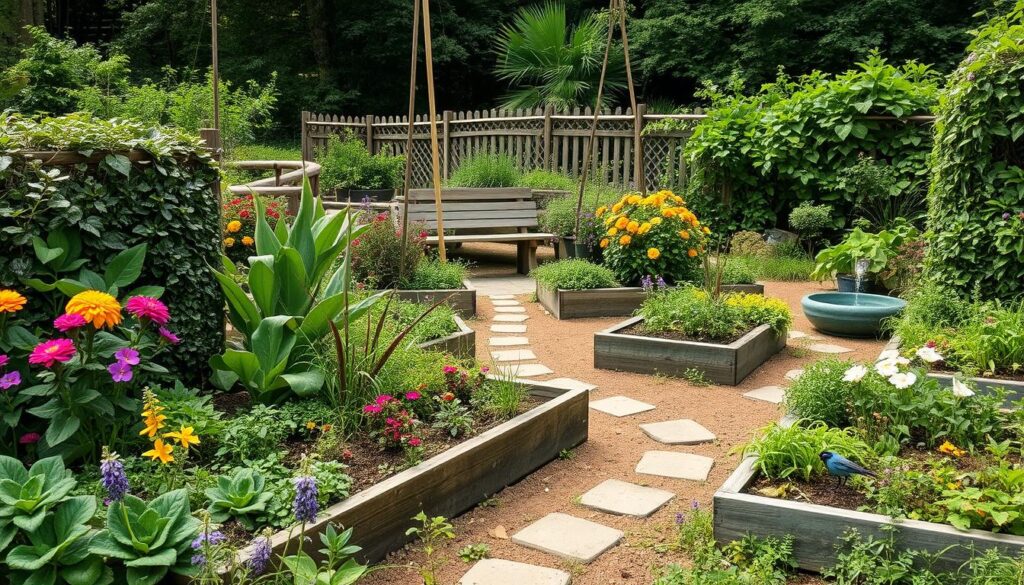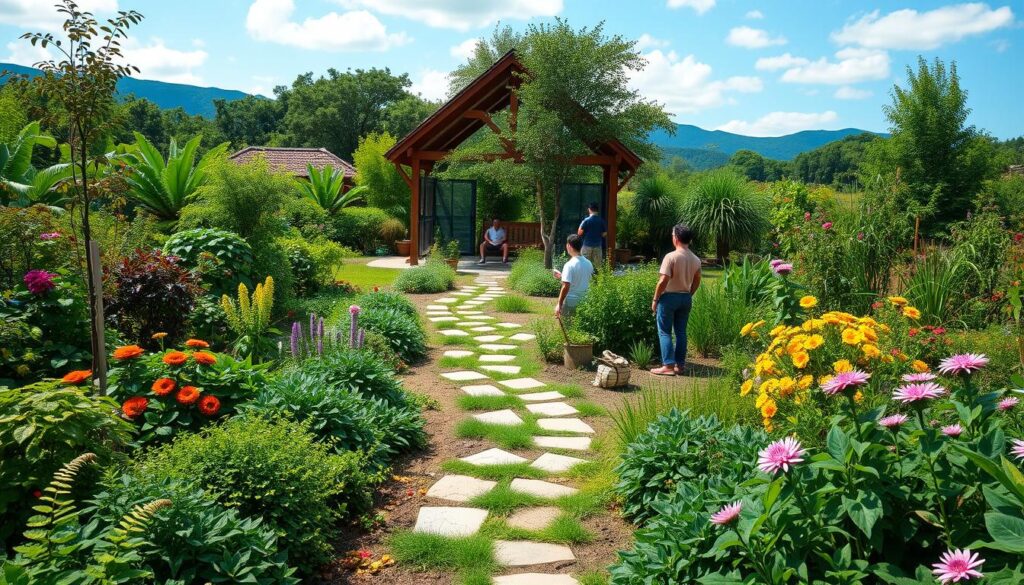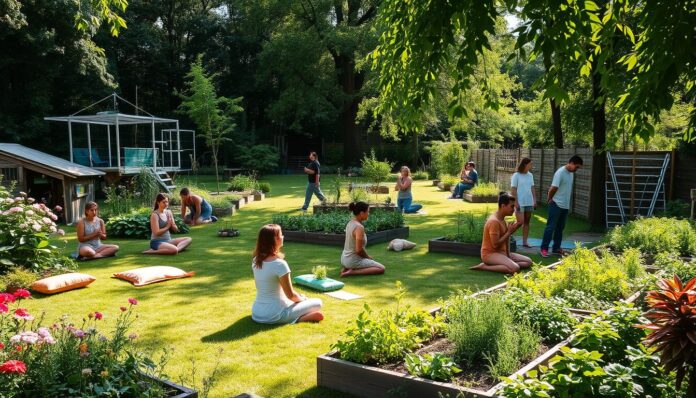When I first learned about permaculture, my view of the world changed. Nature became a healing place, not just a background. This showed me a deep way to heal that’s different from usual therapy.
Permaculture started in the mid-1970s. It’s a new way to connect with nature that helps us feel better. Studies show that being in nature improves our health and emotional strength.
The magic of permaculture is in its whole approach. It mixes nature with healing to change lives. This method is more than just treating sickness. It creates spaces where nature heals us through design and interaction.
Key Takeaways
- Permaculture offers new ways to heal
- Nature therapy boosts our mental and physical health
- Sustainable design helps us heal emotionally and ecologically
- Permaculture activities create healing spaces
- Connecting with nature helps us grow and become stronger
Understanding Permaculture and Its Benefits
Permaculture is a new way to live sustainably, going beyond just gardening. This holistic design system works like nature to make places that are good for people and the planet.
What is Permaculture?
Permaculture is all about living in harmony with nature. Ecotherapy and healing gardens are big parts of this. They help us respect and care for our environment.
- Started in the mid-1970s by David Holmgren and Bill Mollison
- Focuses on sustainable and regenerative design
- Integrates human dwellings with natural ecosystems
Principles of Permaculture
Permaculture has key principles that change how we see our world. It’s about making systems that give back more to the earth than we take.
| Principle | Description |
|---|---|
| Observe and Interact | Understanding natural patterns before intervention |
| Catch and Store Energy | Maximizing resource utilization |
| Obtain a Yield | Ensuring productive and sustainable systems |
Why Permaculture Matters
help us feel better, both inside and out.
“Permaculture is a design approach that teaches us to work with, not against, nature.” – Bill Mollison
Permaculture blends nature’s wisdom with our needs. It makes spaces that are good for us and the earth. This makes it a strong tool for living sustainably and healing ourselves.
The Concept of Therapeutic Activities
Therapeutic activities are a powerful way to heal by connecting people with nature. They use our natural bond with the outdoors to help us grow. This approach supports our mental, emotional, and physical health.

Definition of Therapeutic Activities
Therapeutic activities are special ways to interact with nature to heal and grow. They offer a variety of experiences. These include:
- Reducing stress and anxiety
- Improving mental health
- Enhancing physical functioning
- Building social connections
Importance of Nature in Therapy
Biophilic design is key in making healing spaces. Studies show nature-based therapy has big benefits:
| Activity | Health Benefit | Impact Percentage |
|---|---|---|
| Gardening | Stress Reduction | 30-40% |
| Outdoor Activities | Blood Pressure Reduction | 5-10% |
| Nature Engagement | Cortisol Level Decrease | 25-35% |
“Nature itself is the best physician” – Hippocrates
Therapeutic activities do more than just help our bodies. Restorative landscapes offer a complete way to improve our well-being. They help us change and heal emotionally.
The Role of Nature in Healing
Nature has deep healing powers that go beyond just looking good. Green care and horticultural therapy show how we connect with nature. They show how nature can change our well-being.
Our bond with nature, called biophilia, shows how closely we’re tied to it. Studies show many benefits of being in green spaces:
- Less stress and anxiety
- Better mood and emotional control
- Improved thinking
- Stronger mental health
Biophilia: Understanding Our Natural Connection
Biophilia says we naturally want to connect with nature. Horticultural therapy lets people heal through nature. It helps with both mental and physical health.
“In every walk with nature, one receives far more than he seeks.” – John Muir
Psychological Benefits of Green Spaces
Green spaces offer great healing chances. Gentle gardening helps manage stress and boosts mood. By using permaculture, these areas become healing places for both people and nature.
| Nature Interaction | Psychological Benefit |
|---|---|
| Gardening | Stress Reduction |
| Forest Walks | Mood Enhancement |
| Plant Cultivation | Cognitive Improvement |
Nature’s healing power keeps inspiring new ways in green care. It shows healing is more than just medicine. It’s a whole experience tied to our natural world.
How Permaculture Promotes Therapeutic Activities
Permaculture offers a unique way to heal that goes beyond usual methods. It combines nature and community, making therapeutic horticulture a powerful tool for mental health. The design of permaculture supports healing for both individuals and groups.
Gardening as Therapy
Therapeutic horticulture turns gardening into a deep healing experience. Studies show that being in nature can boost mental health by 20-25%. People in permaculture activities often see big improvements in:
- Stress reduction
- Emotional well-being
- Physical health
- Personal autonomy

Community Engagement and Support
Permaculture activities build strong social bonds. These programs can increase community involvement by up to 50%. People learn to:
- Improve social skills
- Build strong support networks
- Enhance communication
“Nature heals not just the individual, but the entire community through interconnected experiences.”
The effects of permaculture go beyond just healing. It makes people more resilient and teaches them to live sustainably. This benefits both personal and environmental health.
| Activity Type | Well-being Impact | Skill Development |
|---|---|---|
| Garden Therapy | 20-25% Mental Health Improvement | Gardening Techniques |
| Community Workshops | 30% Social Connectivity Increase | Sustainable Practices |
| Mindfulness Sessions | 35% Stress Reduction | Emotional Regulation |
Types of Therapeutic Activities in Permaculture
Permaculture is a rich field for nature therapy and ecotherapy. It offers new ways to heal by connecting with nature. These activities mix nature with mental health support, leading to big changes in people.
There are three main types of therapeutic activities in permaculture. Each one helps with overall well-being:
- Horticultural Therapy
- Eco-Therapy
- Mindfulness Practices
Horticultural Therapy
Horticultural therapy uses gardening and plants to help with mental and physical health. It falls into three main areas:
- Vocational Programs: Helps develop job skills
- Therapeutic Programs: Supports personal recovery
- Social Programs: Boosts overall well-being
Eco-Therapy Practices
Ecotherapy uses nature to tackle mental health issues. Studies show that being outdoors can lower anxiety and depression.
“Connecting with nature is not just a recreational activity, but a powerful healing mechanism.” – Ecological Psychology Research Institute
| Therapeutic Approach | Key Benefits | Target Population |
|---|---|---|
| Forest Bathing | Stress Reduction | General Population |
| Garden-Based Therapy | Skill Development | Rehabilitation Patients |
| Wilderness Therapy | Emotional Regulation | At-Risk Individuals |
Mindfulness Practices in Nature
Mindfulness in permaculture helps people connect more with nature. It includes meditation, noticing senses, and journaling in the outdoors.
Permaculture combines nature therapy and ecotherapy for a complete healing space. It supports mental, emotional, and physical health.
Permaculture Design for Therapeutic Spaces
Creating healing gardens through biophilic design turns outdoor spaces into powerful healing places. Permaculture guides the creation of spaces that help both humans and nature. These landscapes do more than look good; they offer deep healing.

Key Elements of Therapeutic Gardens
Successful healing gardens have a few key parts:
- Sensory-rich environments with diverse plant selections
- Strategic water features for acoustic comfort
- Microclimate management using natural elements
- Spaces that encourage mindful interaction
Designing for Accessibility
Biophilic design makes sure everyone can enjoy therapeutic spaces. It includes things like easy pathways, raised garden beds, and tools for all.
“A well-designed garden heals not just the body, but the soul.” – Landscape Design Expert
Functional Design Strategies
Permaculture uses design that works for both nature and healing. Here are some smart ideas:
- Capturing rainwater for gravity-fed irrigation
- Using stones to create heat-absorbing microclimates
- Incorporating sensory plants with therapeutic properties
| Design Element | Therapeutic Benefit | Ecological Impact |
|---|---|---|
| Raised Garden Beds | Improved Accessibility | Enhanced Soil Management |
| Water Features | Stress Reduction | Wildlife Habitat Creation |
| Diverse Plant Selection | Sensory Stimulation | Biodiversity Support |
Studies show that well-designed healing gardens can really help. They can lower stress, boost mental health, and connect us with nature.
Benefits of Participating in Therapeutic Activities
Permaculture offers a new way to heal through restorative landscapes. These landscapes help both our emotional and physical health. Green care practices give people a chance to do meaningful, therapeutic work.
Doing permaculture-based activities can greatly improve our health and life quality. Studies show these activities have a big impact on our well-being.
Emotional Well-being Breakthroughs
Permaculture’s therapeutic activities bring big emotional health benefits:
- More than 80% of people feel happier
- Stress levels drop by up to 60%
- Self-esteem goes up through meaningful work
- Feeling lonely goes down
Physical Health Improvements
The physical benefits of restorative landscapes are also huge:
| Health Outcome | Improvement Percentage |
|---|---|
| Physical Mobility | 70% |
| Cardiovascular Health | Significant Reduction in Morbidity |
| Muscle Strength | 45% Increase |
| Risk Reduction for Chronic Diseases | Multiple Conditions Impacted |
“Nature’s therapy is the most holistic approach to healing the body and mind.” – Green Care Research Institute
People aged 60-95 saw amazing results. Gardening gave them big social and physical benefits. Green care interventions are a strong, natural way to improve overall wellness.
Case Studies of Permaculture and Therapy
Real-world examples show how horticultural therapy changes lives in permaculture systems. Studies and community stories show deep healing through gardening.

Success Stories from Community Gardens
Community gardens are key for healing. Research shows gardening helps many people:
- 30% less anxiety and depression
- Lower stress hormone levels
- 50% less dementia risk for seniors
- 40% better mood and self-esteem
Research Findings on Health Outcomes
“Gardening isn’t just about growing plants—it’s about cultivating human potential.”
Gardening heals in ways beyond medicine. Research shows big benefits:
| Metric | Improvement |
|---|---|
| Social Connections | 25% increase |
| Pharmacological Intervention Reduction | 20% decrease |
| Overall Quality of Life | 15% improvement |
Soil bacteria like Mycobacterium vaccae boost serotonin. This natural support helps mental health through gardening.
These stories highlight the power of gardening therapy. It improves well-being for all ages and backgrounds.
Incorporating Permaculture into Therapeutic Programs
Permaculture offers a new way to heal through nature. It combines design with healing practices. This creates powerful wellness experiences that connect people with nature.
Structuring Therapeutic Permaculture Workshops
Creating effective permaculture activities needs careful planning. Important things to consider are:
- Creating spaces for all participants
- Developing fun, hands-on learning
- Creating safe and supportive environments
- Adding mental health support
Best Practices for Facilitators
Good nature therapy programs need skilled leaders. They should focus on:
- Understanding each participant’s needs
- Adapting activities for all skill levels
- Building community
- Being trauma-informed
| Workshop Component | Key Objectives |
|---|---|
| Introduction | Build trust and establish safety |
| Skill Development | Teach permaculture principles |
| Practical Application | Hands-on gardening and design |
| Reflection | Process emotional experiences |
“Nature therapy through permaculture creates spaces of healing, learning, and personal transformation.”
By using these strategies, facilitators can create valuable permaculture activities. These activities support mental health and build community strength.
Challenges in Implementing Therapeutic Activities
Starting ecotherapy and healing gardens comes with its own set of challenges. These need careful thought and creative solutions. Activities in permaculture systems must consider participant needs and find ways to overcome obstacles.
Common Obstacles in Nature-Based Therapy
Professionals face several big challenges when creating therapeutic activities:
- Limited physical capabilities of participants
- Varying energy levels and engagement
- Resource constraints
- Potential participant resistance to new approaches
Strategic Solutions to Enhance Engagement
To succeed in ecotherapy, we need new ways to tackle these challenges:
- Customize activities for individual abilities
- Develop flexible program structures
- Create supportive community environments
- Implement adaptive design in healing gardens
“Nature’s therapeutic potential emerges when we design programs that meet participants exactly where they are.” – Environmental Therapy Research Group
Studies show that nature-based interventions can greatly help mental health. About 25 studies have shown positive results, mostly from garden and forest programs. The goal is to make these experiences inclusive and adaptable, turning healing gardens into places of change.
By focusing on individual needs and removing barriers, we can unlock the full potential of permaculture systems. This leads to personal growth and wellness.
Engaging Different Populations in Therapeutic Activities
Permaculture activities bring people together with nature’s healing power. Green care practices make spaces where everyone feels welcome. This includes people of all ages and backgrounds.
Empowering Children through Nature
Children’s gardening programs are very beneficial. They help kids develop important skills like:
- Responsibility and patience
- Self-confidence
- Critical thinking
- Environmental awareness
By seeing kids as capable, we can teach them valuable lessons. These lessons inspire them to care for the environment.
Supporting Senior Community Engagement
The Social Peas project shows how important it is to fight loneliness in seniors. Permaculture activities help seniors in many ways, like:
- Active aging
- Cognitive stimulation
- Social connection
Community gardens help bridge the gap between generations. They create spaces for learning and support.
Inclusive Practices for Diverse Communities
Creating welcoming spaces needs careful planning. Therapeutic gardens should have features like raised beds and firm paths. This makes sure everyone can join in and enjoy green care activities.
By valuing diversity and adjusting permaculture, we can build strong, caring ecological spaces. These spaces support well-being for everyone.
Measuring the Effectiveness of Therapeutic Activities
Measuring the success of horticultural therapy is key. It involves looking at both obvious and hidden benefits. Restorative landscapes offer a special chance to see how well therapy works.
Experts have created advanced tools to measure the success of nature-based therapy. These tools help us see how deeply therapy can heal.
Assessment Tools and Techniques
Important methods include:
- Standardized psychological well-being scales
- Physiological measurement techniques
- Observational tracking protocols
- Self-reported participant surveys
“Measurement is the first step that leads to control and eventually to improvement.” – Harry Kennard
Participant Feedback Collection
Getting feedback from participants is crucial. It helps improve programs. Effective ways to collect feedback are:
- Structured interviews
- Anonymous questionnaires
- Focus group discussions
- Long-term follow-up assessments
| Assessment Method | Key Metrics | Data Collection Frequency |
|---|---|---|
| Psychological Scales | Stress Levels | Pre/Post Treatment |
| Healthcare Utilization | GP Contact Reduction | 12 Months |
| Work Performance | Return to Work Rate | Annual Review |
Research shows great promise in therapy. For example, 44.2% of patients went back to work a year after nature therapy. This shows how powerful horticultural therapy can be in healing environments.
Future Trends in Permaculture and Therapeutic Activities
The world of therapeutic horticulture is changing fast. New ways to heal through nature are being discovered. Studies show that ecotherapy is getting more advanced, linking mental health with caring for the environment.
New tech is changing how we do therapy in permaculture. Virtual reality lets people experience nature even when they can’t be there. This makes healing through nature more available to everyone.
Cities are now seeing the importance of green spaces for people’s health. Places like Portland and Seattle are using permaculture in public areas. These spaces help with mental health and fixing the environment. They show how nature can solve big problems.
The future of healing looks at the whole picture, including nature. As the planet faces big challenges, ecotherapy and horticulture are key. They help us stay strong and connect with nature and ourselves.
Innovations in Therapy through Nature
New studies are finding links between our minds and nature. Schools are starting programs to teach about therapeutic horticulture. It’s seen as a powerful way to heal and change lives.

